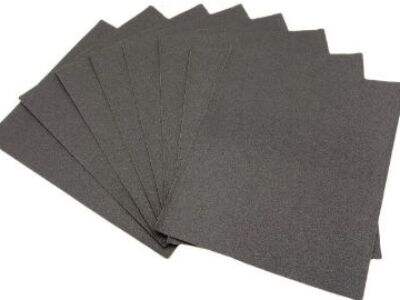This is a tool which enables humans to polish roughness & find something pleasant to look at, e.g. sandpaper. Sandpaper comes in various forms, including paper, cloth, and plastic. They assist us with varying sanding tasks, generally bringing us different types of materials for both wood, metal, and plastic. And here’s what we know about sandpaper: Its ingredients, its grits, how we use it.
They are utilized to create a variety of abrasive tools, from fine papers to steel discs, to emery wheels, to name a few, this is the reason if you ever wondered what is sandpaper made of; Keep reading to find out more about its materials.
Sandpaper comes one many different materials. Paper, cloth, and plastic are the most common. Paper sandpaper is the most common and is suitable for general sanding tasks. Cloth sandpaper is stiffer and is used for jobs such as rough sanding. It is waterproof plastic sandpaper suitable for wet sanding applications. Each one is best for a different types of jobs and surfaces.
What Are Grits in Sanding?
Grits are little bits that cling to sandpaper to smooth surfaces. A higher grit number means the bits are finer, thereby providing us a smoother finish. The lower the grit number, the rougher the sandpaper and the more removal it does, such as with paint, while higher grit such as 600 is smoother, for finishing. Higher grit sandpaper, such as 220 or 320 grit, is smoother and utilized for finishing and polishing surfaces. Select the proper grit for your sanding project.
Picking the Correct Sandpaper for Your Project
When selecting Sanding Pad for a project, consider what it is that you are sanding and the extent of sanding that must be done. For wood surfaces, use the lower grit sandpaper to remove bumps and higher grits for smoothness. For metal surfaces, you will require more powerful sandpaper, cloth-backed sandpaper. If you have plastic surfaces, use waterproof sandpaper for wet sanding. To get the best results, you should always select the correct grit for the job.
Tips for Using Sandpaper Well
To sandpaper effectively, sand along the direction of the wood grain to obtain a smooth finish. Any uneven sanding can be avoided by maintaining constant pressure with a sanding block or tool. Always start with a low grit and use progressively higher grits for a shiny finish. To make sandpaper last, keep it clean by tapping out the dust or using a cleaner. Use goggles or a mask when sanding to protect yourself from the dust.
Tending to Your Sandpaper Tools
Store your Sand Paper tools in a dry and cool place to add durability and forestall moisture damage. After using sandpaper, tab off the dust with a nail to clean it or use a cleaner and remove the debris. Avoid pressing down too hard when sanding, as this causes the sandpaper to wear out quickly. Replace worn sandpaper with new sheets so sanding goes smoothly. Cared for properly, your sandpaper tools will provide you smooth, polished surfaces for all your sanding projects!
Ultimately, sandpaper is a useful tool as it helps you create smooth, nice surfaces on a variety of materials. With knowledge of sandpaper materials, the types of grit, choosing the right sandpaper for each job, how to use it properly, and extending the life of our tools, we can achieve great results. And match the grit to the job, wear safety gear and follow good sanding technique for the best results. Pangea sands like a dream!
 EN
EN
 AR
AR
 NL
NL
 FR
FR
 DE
DE
 KO
KO
 PL
PL
 PT
PT
 RU
RU
 ES
ES
 AF
AF
 LA
LA


